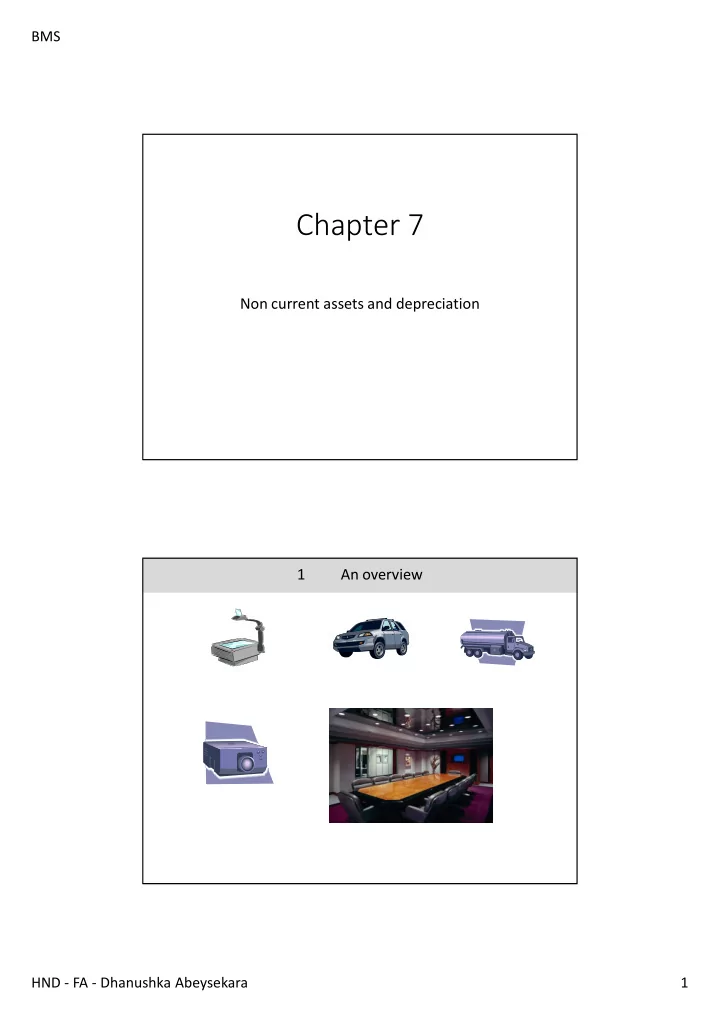

BMS Chapter 7 Non current assets and depreciation 1 An overview HND - FA - Dhanushka Abeysekara 1
BMS Cost = $7000 Useful life = 3 years Value at the end of useful life = $1000 HND - FA - Dhanushka Abeysekara 2
BMS SOFP of year 1 SOFP of year 2 SOFP of year 3 Cost Residual value/ $7000 Scrap value Net Book Value/ Net Book Value/ $1000 Carrying Amount Carrying Amount $5000 $3000 Year 1 Year 2 Year 3 Depreciation Depreciation Depreciation (Expense for the year) (Expense for the year) (Expense for the year) $2000 $2000 $2000 P or L of Year 1 P or L of Year 2 P or L of Year 3 2 Accounting for non-current assets - Terminologies Cost : The original cost of purchase Useful life : The useful time period or the volume of output that can be generated (Estimated) Scrap value : Value at the end of useful life (Estimated). Also known as residual value Depreciation : Systematic allocation of cost over the useful life (Estimated) Net book value: The remaining value at a given point* (Estimated). Also known as Carrying amount *NBV = Cost – Accumulated depreciation HND - FA - Dhanushka Abeysekara 3
BMS 3 Depreciation Depreciation does not stay the same for all the assets Example 1: Cars Every year same amount. Computers Early years higher depreciation. Since depreciation is different from asset to asset, we need to have methods of calculating depreciation. There are 3 mainly used methods, 1. Straight line method 2. reducing balance method 3. Machine hour/ units of production method 3.1 Straight-line method In this method the amount of depreciation stays the same every year Example 2: A company bought a motor vehicle which had following information cost – $55000 Estimated useful life – 10 years Residual value – $5,000 Calculate the depreciation per year and fill up the following table for first three years. Depreciation per year = $55,000 - $5,000 10 years = $5,000 HND - FA - Dhanushka Abeysekara 4
BMS Year 1 Asset (Cost) 55,000 Bank 55,000 Bal C/f 1 Depreciation expense Accumulated depreciation 5,000 P or L 5,000 2 3 Accumulated depreciation 5,000 Bal C/f Depreciation expense 5,000 2 Year 2 Asset (Cost) 55,000 Bal b/f 55,000 Bal C/f 1 Depreciation expense Accumulated depreciation 5,000 P or L 5,000 3 4 Accumulated depreciation Bal b/f 5,000 2 Depreciation expense 5,000 3 10,000 Bal C/f 5 10,000 10,000 HND - FA - Dhanushka Abeysekara 5
BMS Year 3 Asset (Cost) 55,000 55,000 Bal C/f Bal b/f 1 Depreciation expense 5,000 Accumulated depreciation P or L 5,000 3 4 Accumulated depreciation Bal b/f 10,000 2 Depreciation expense 5,000 3 Bal C/f 15,000 5 15,000 15,000 Accumulated depreciation Year 1 Year 1 5,000 Depreciation expense Bal C/d 5,000 Year 2 Year 2 Bal b/d 5,000 Depreciation expense 5,000 10,000 Bal C/d 10,000 10,000 Year 3 Year 3 Bal b/d 10,000 Depreciation expense 5,000 15,000 Bal C/d 15,000 15,000 Year 4 Year 4 Bal b/d 15,000 HND - FA - Dhanushka Abeysekara 6
BMS 3.2 Reducing balance method In this method assets depreciate more in early years than they do in later years Example 3: A company bought a motor vehicle which had following information cost – $50000 Estimated useful life – 10 years Residual value – $5,000 Calculate the depreciation per year if the depreciation rate is 20% Depreciation for year 1 = $50,000 x 20% = $10,000 NBV at the end of year 1 = $50,000 - $10,000 = $40,000 Depreciation for year 2 = x = $40,000 20% $8,000 NBV at the end of year 2 = $50,000 - ($10,000 + $8,000) = $32,000 Depreciation for year 3 = x = $32,000 20% $6,400 NBV at the end of year 3 + $8,000 + $6,400) = = $50,000 - ($10,000 $25,600 Review Questions – 27.1 Review Questions – 27.2 HND - FA - Dhanushka Abeysekara 7
BMS Example 4: XYZ: trial balance as at 31 December 2003 Debit (Rs.) Credit (Rs.) Purchases and Sales 99,850 126,500 Premises : Cost 100,000 Accumulated depreciation at 1 January 2003 25,000 Plant : Cost 18,000 Accumulated depreciation at 1 January 2003 2,300 Wages and salaries 8,900 Rent and local business tax 7,500 Inventories at 1 January 2003 5,000 Capital at 1 January 2003 80,000 Drawings 25,000 Carriage inwards 4,000 Receivables and payables 32,500 16,000 Rent income 2,000 Bank balance 18,950 10% Bank loan 30,000 300,750 300,750 Additional information: 1. Stock at 31 December 2003 was $12,500 2. Bad debts of $5,000 to be written-off. Provision for doubtful debts of 2% to be made 3. Depreciation is to be charged at 2 % of cost on premises, and at 10 % of cost on plant. Prepare Statement of profit or loss and statement of financial position Rs. Rs. Example 5 Building at cost 240,000 Plant at cost 160,000 Accumulated depreciation at star of year On buildings 40,000 On plant 76,000 Purchases and sales 500,000 808,800 Inventories at start of year 100,000 Discounts 36,000 9,600 Returns 4,400 30,000 Wages and salaries 117,600 Other expenses 45,600 Receivables and payables 85,200 72,000 Bank and cash 3,200 Drawings 48,000 Provision for doubtful debts 1,000 Opening capital 302,600 1,340,000 1,340,000 Additional information: 1. Stock at 31 December 2003 was $84,000 2. Bad debts of $9,200 to be written-off. Provision for doubtful debts of 2% to be made 3. Depreciation is to be charged at 1.5 % of cost on buildings, and at 25% of cost on plant. Prepare Statement of profit or loss and statement of financial position HND - FA - Dhanushka Abeysekara 8
BMS Readings Study text – Chapter 26 – 26.1 to 26.11 HND - FA - Dhanushka Abeysekara 9
Recommend
More recommend